Analysis of COVID-19's Impact on the US Economy and Policies
VerifiedAdded on 2022/08/29
|6
|1203
|16
Report
AI Summary
This report provides an overview of the economic challenges posed by the COVID-19 pandemic and the responses of the US government. It details the implementation of monetary and fiscal policies, including the Federal Reserve's interventions, emergency funding packages, and measures such as interest rate cuts and quantitative easing. The report also covers fiscal measures like the declaration of a national emergency, student loan relief, and aid to employees and businesses. It explores the impact of these policies on the financial markets and the broader economy, referencing key legislative actions and government announcements. The conclusion summarizes the ongoing efforts to stabilize the economy amidst the crisis, emphasizing the dynamic nature of the government's response. The report references several academic sources to support its analysis.
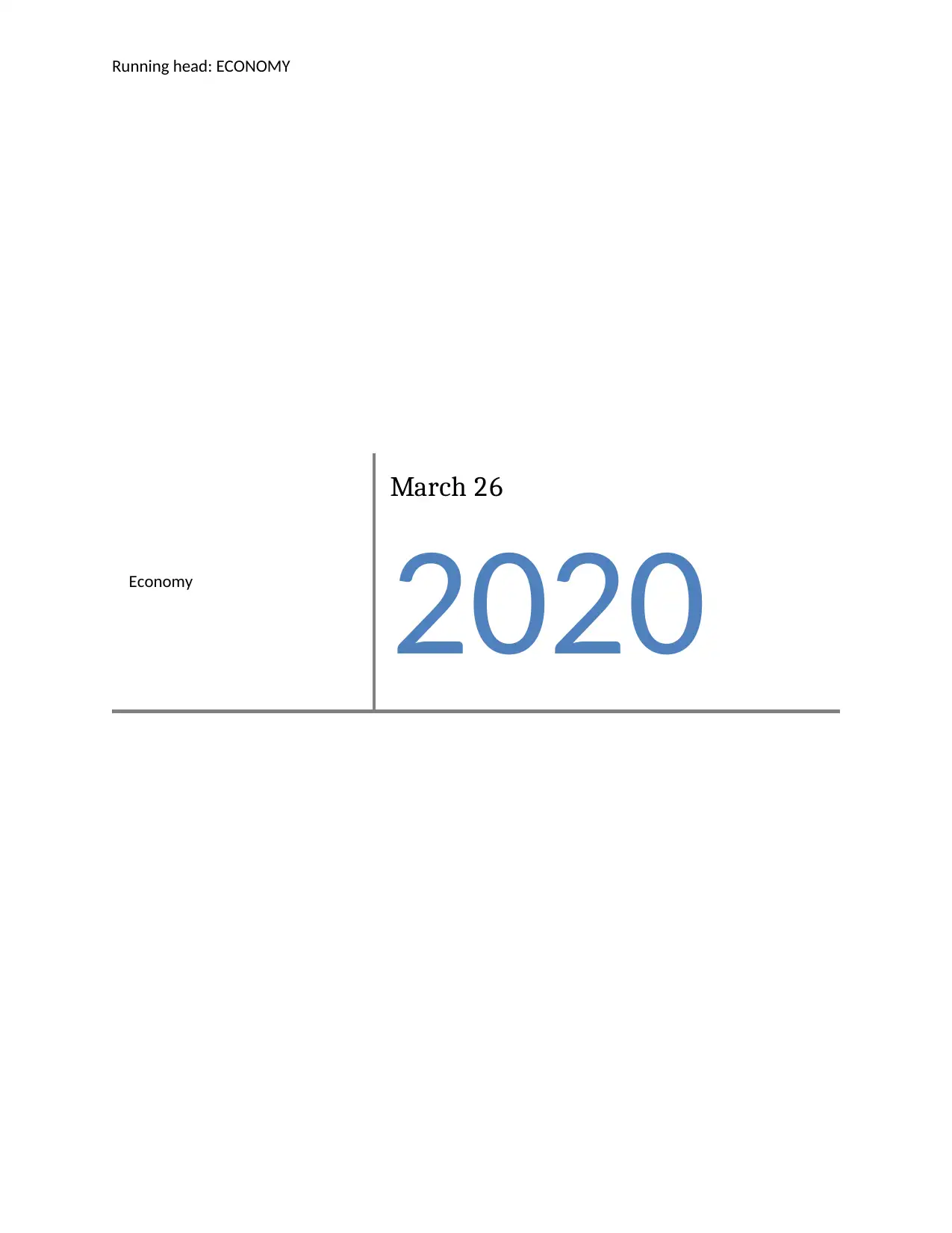
Running head: ECONOMY
Economy
March 26
2020
Economy
March 26
2020
Paraphrase This Document
Need a fresh take? Get an instant paraphrase of this document with our AI Paraphraser
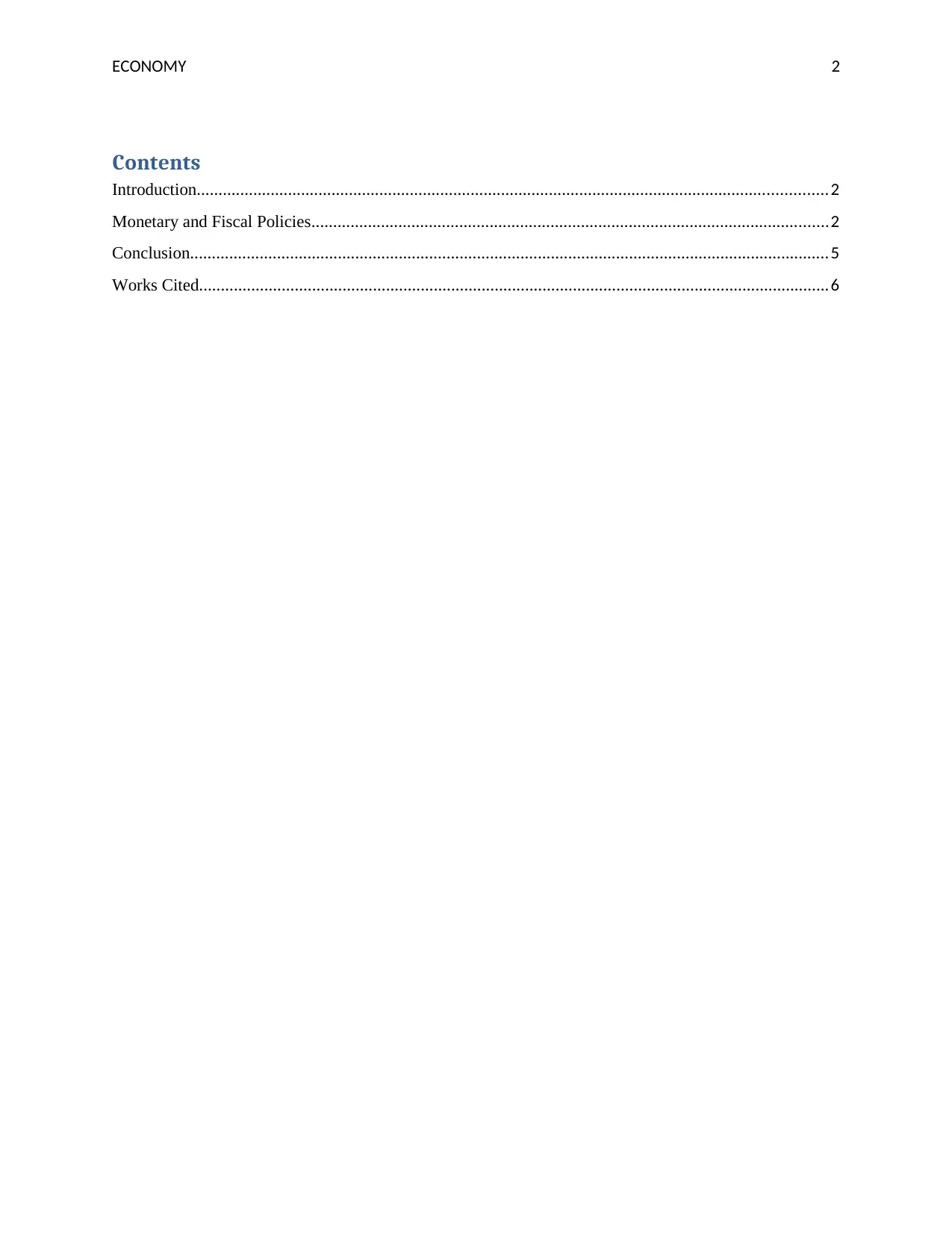
ECONOMY 2
Contents
Introduction.................................................................................................................................................2
Monetary and Fiscal Policies.......................................................................................................................2
Conclusion...................................................................................................................................................5
Works Cited.................................................................................................................................................6
Contents
Introduction.................................................................................................................................................2
Monetary and Fiscal Policies.......................................................................................................................2
Conclusion...................................................................................................................................................5
Works Cited.................................................................................................................................................6
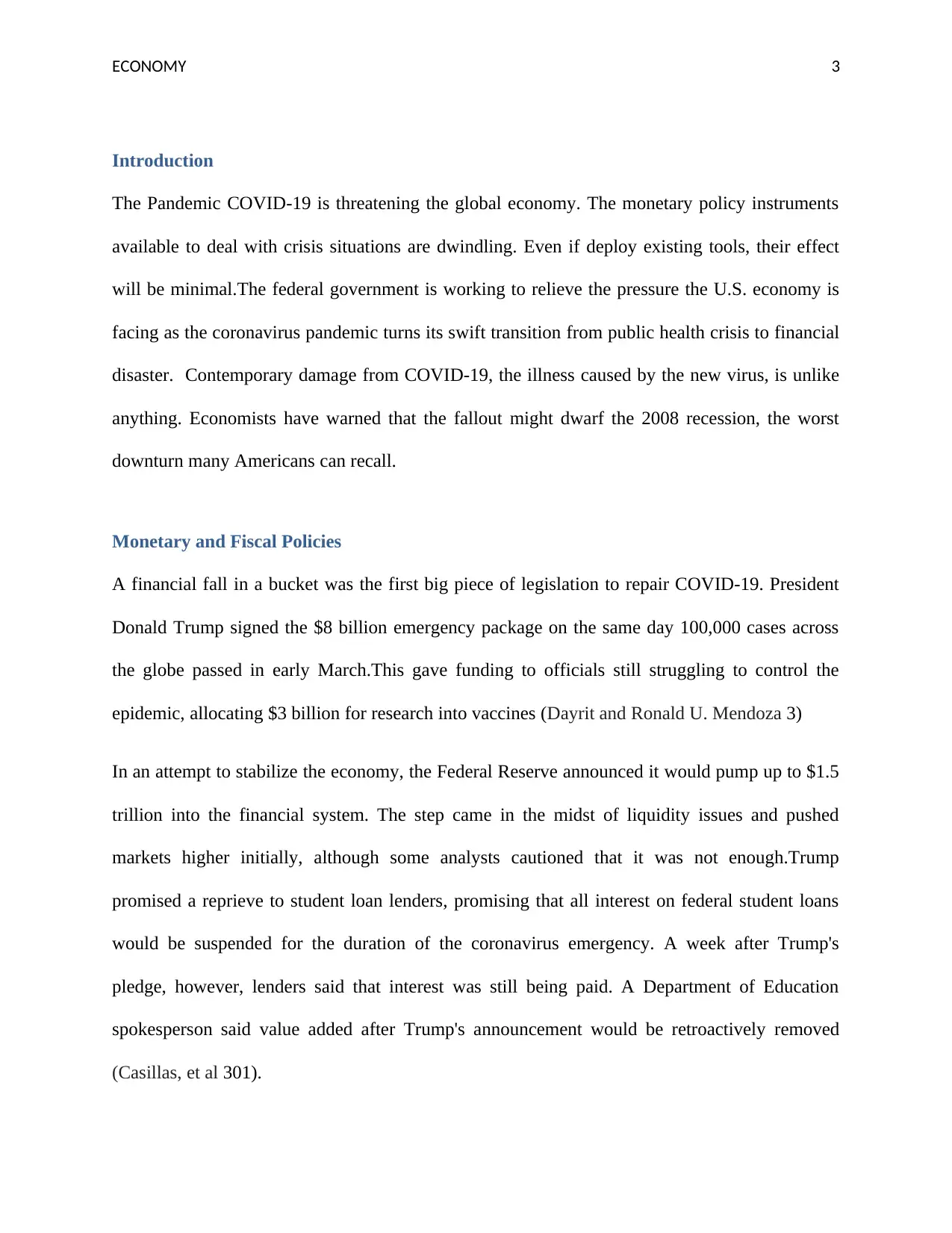
ECONOMY 3
Introduction
The Pandemic COVID-19 is threatening the global economy. The monetary policy instruments
available to deal with crisis situations are dwindling. Even if deploy existing tools, their effect
will be minimal.The federal government is working to relieve the pressure the U.S. economy is
facing as the coronavirus pandemic turns its swift transition from public health crisis to financial
disaster. Contemporary damage from COVID-19, the illness caused by the new virus, is unlike
anything. Economists have warned that the fallout might dwarf the 2008 recession, the worst
downturn many Americans can recall.
Monetary and Fiscal Policies
A financial fall in a bucket was the first big piece of legislation to repair COVID-19. President
Donald Trump signed the $8 billion emergency package on the same day 100,000 cases across
the globe passed in early March.This gave funding to officials still struggling to control the
epidemic, allocating $3 billion for research into vaccines (Dayrit and Ronald U. Mendoza 3)
In an attempt to stabilize the economy, the Federal Reserve announced it would pump up to $1.5
trillion into the financial system. The step came in the midst of liquidity issues and pushed
markets higher initially, although some analysts cautioned that it was not enough.Trump
promised a reprieve to student loan lenders, promising that all interest on federal student loans
would be suspended for the duration of the coronavirus emergency. A week after Trump's
pledge, however, lenders said that interest was still being paid. A Department of Education
spokesperson said value added after Trump's announcement would be retroactively removed
(Casillas, et al 301).
Introduction
The Pandemic COVID-19 is threatening the global economy. The monetary policy instruments
available to deal with crisis situations are dwindling. Even if deploy existing tools, their effect
will be minimal.The federal government is working to relieve the pressure the U.S. economy is
facing as the coronavirus pandemic turns its swift transition from public health crisis to financial
disaster. Contemporary damage from COVID-19, the illness caused by the new virus, is unlike
anything. Economists have warned that the fallout might dwarf the 2008 recession, the worst
downturn many Americans can recall.
Monetary and Fiscal Policies
A financial fall in a bucket was the first big piece of legislation to repair COVID-19. President
Donald Trump signed the $8 billion emergency package on the same day 100,000 cases across
the globe passed in early March.This gave funding to officials still struggling to control the
epidemic, allocating $3 billion for research into vaccines (Dayrit and Ronald U. Mendoza 3)
In an attempt to stabilize the economy, the Federal Reserve announced it would pump up to $1.5
trillion into the financial system. The step came in the midst of liquidity issues and pushed
markets higher initially, although some analysts cautioned that it was not enough.Trump
promised a reprieve to student loan lenders, promising that all interest on federal student loans
would be suspended for the duration of the coronavirus emergency. A week after Trump's
pledge, however, lenders said that interest was still being paid. A Department of Education
spokesperson said value added after Trump's announcement would be retroactively removed
(Casillas, et al 301).
⊘ This is a preview!⊘
Do you want full access?
Subscribe today to unlock all pages.

Trusted by 1+ million students worldwide
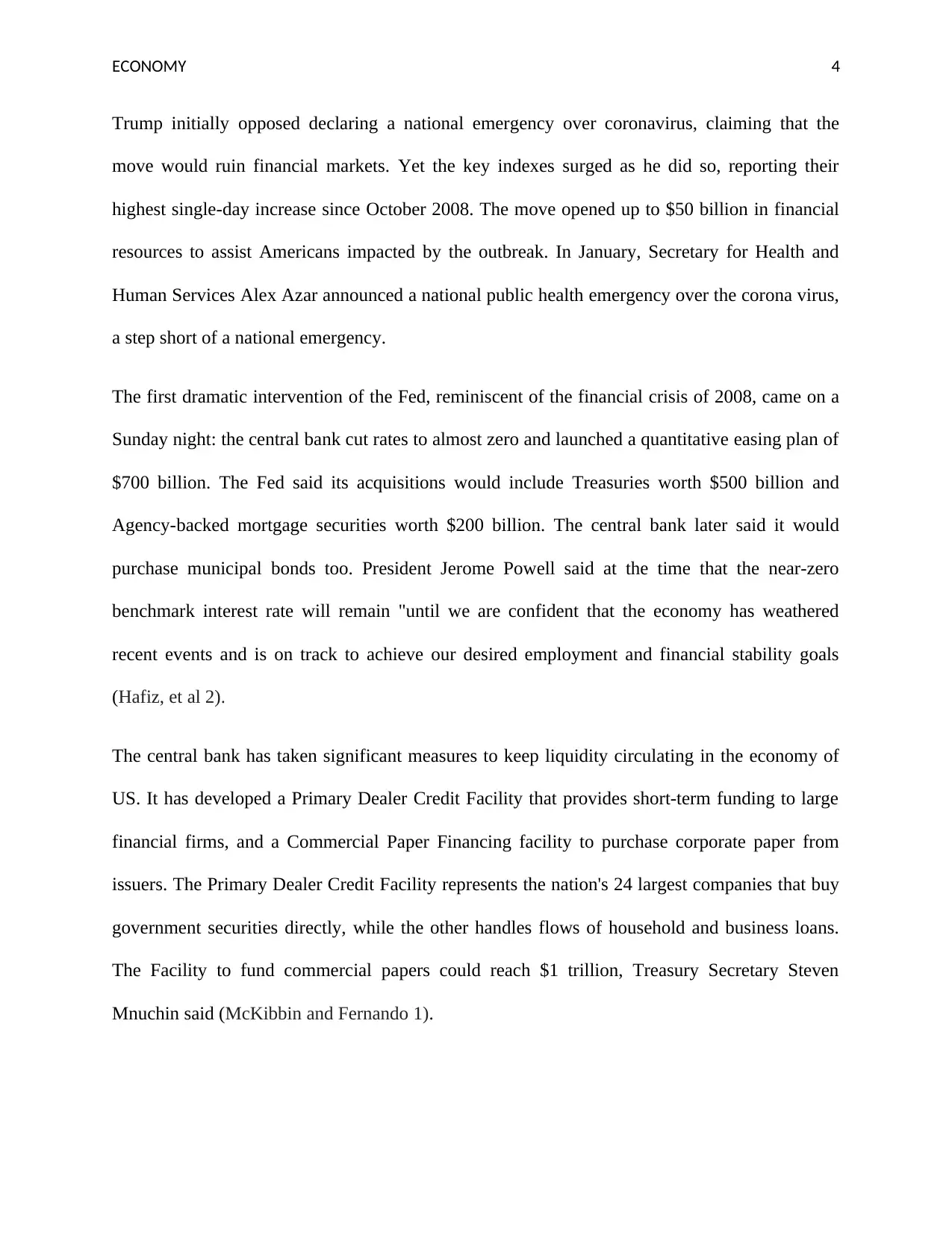
ECONOMY 4
Trump initially opposed declaring a national emergency over coronavirus, claiming that the
move would ruin financial markets. Yet the key indexes surged as he did so, reporting their
highest single-day increase since October 2008. The move opened up to $50 billion in financial
resources to assist Americans impacted by the outbreak. In January, Secretary for Health and
Human Services Alex Azar announced a national public health emergency over the corona virus,
a step short of a national emergency.
The first dramatic intervention of the Fed, reminiscent of the financial crisis of 2008, came on a
Sunday night: the central bank cut rates to almost zero and launched a quantitative easing plan of
$700 billion. The Fed said its acquisitions would include Treasuries worth $500 billion and
Agency-backed mortgage securities worth $200 billion. The central bank later said it would
purchase municipal bonds too. President Jerome Powell said at the time that the near-zero
benchmark interest rate will remain "until we are confident that the economy has weathered
recent events and is on track to achieve our desired employment and financial stability goals
(Hafiz, et al 2).
The central bank has taken significant measures to keep liquidity circulating in the economy of
US. It has developed a Primary Dealer Credit Facility that provides short-term funding to large
financial firms, and a Commercial Paper Financing facility to purchase corporate paper from
issuers. The Primary Dealer Credit Facility represents the nation's 24 largest companies that buy
government securities directly, while the other handles flows of household and business loans.
The Facility to fund commercial papers could reach $1 trillion, Treasury Secretary Steven
Mnuchin said (McKibbin and Fernando 1).
Trump initially opposed declaring a national emergency over coronavirus, claiming that the
move would ruin financial markets. Yet the key indexes surged as he did so, reporting their
highest single-day increase since October 2008. The move opened up to $50 billion in financial
resources to assist Americans impacted by the outbreak. In January, Secretary for Health and
Human Services Alex Azar announced a national public health emergency over the corona virus,
a step short of a national emergency.
The first dramatic intervention of the Fed, reminiscent of the financial crisis of 2008, came on a
Sunday night: the central bank cut rates to almost zero and launched a quantitative easing plan of
$700 billion. The Fed said its acquisitions would include Treasuries worth $500 billion and
Agency-backed mortgage securities worth $200 billion. The central bank later said it would
purchase municipal bonds too. President Jerome Powell said at the time that the near-zero
benchmark interest rate will remain "until we are confident that the economy has weathered
recent events and is on track to achieve our desired employment and financial stability goals
(Hafiz, et al 2).
The central bank has taken significant measures to keep liquidity circulating in the economy of
US. It has developed a Primary Dealer Credit Facility that provides short-term funding to large
financial firms, and a Commercial Paper Financing facility to purchase corporate paper from
issuers. The Primary Dealer Credit Facility represents the nation's 24 largest companies that buy
government securities directly, while the other handles flows of household and business loans.
The Facility to fund commercial papers could reach $1 trillion, Treasury Secretary Steven
Mnuchin said (McKibbin and Fernando 1).
Paraphrase This Document
Need a fresh take? Get an instant paraphrase of this document with our AI Paraphraser
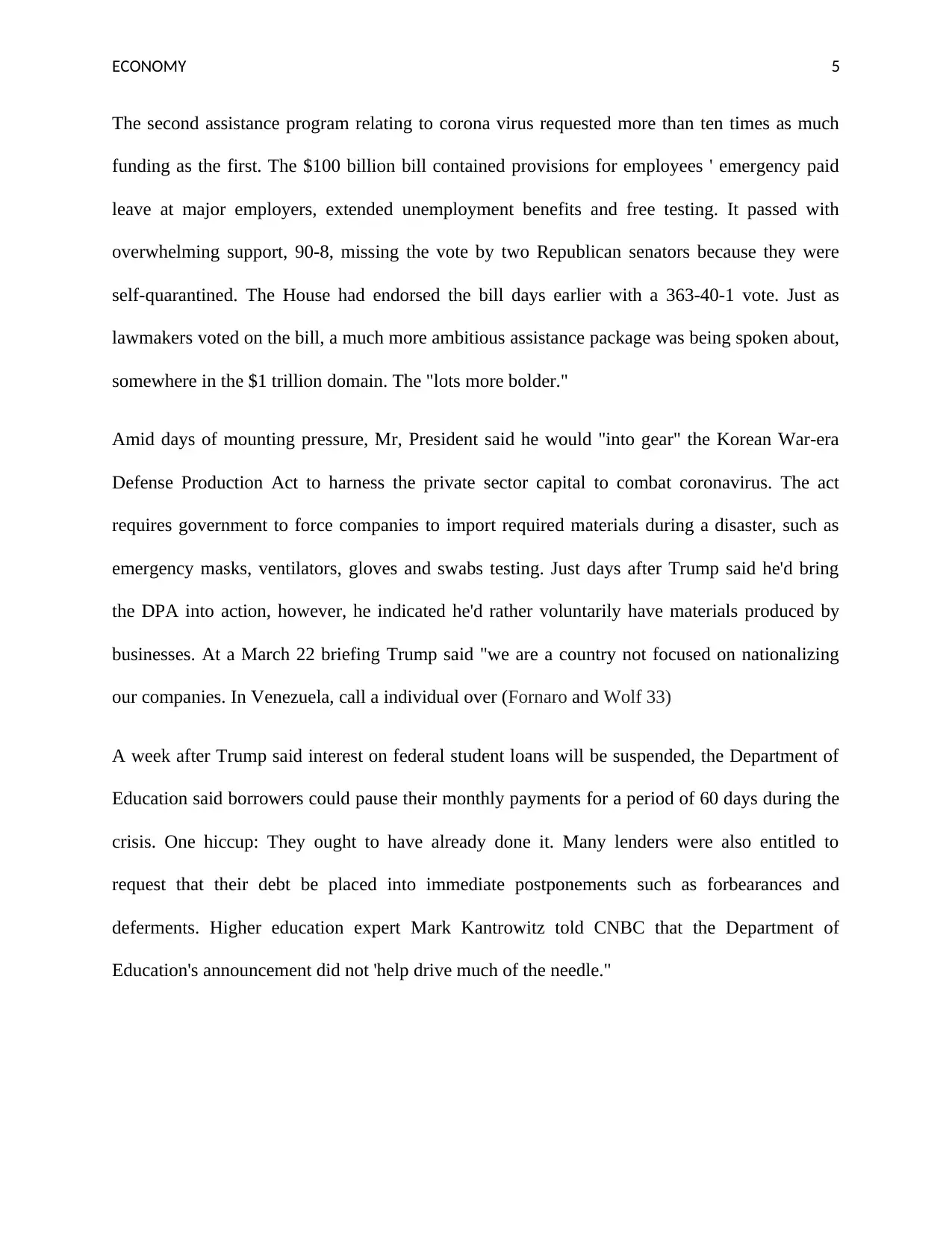
ECONOMY 5
The second assistance program relating to corona virus requested more than ten times as much
funding as the first. The $100 billion bill contained provisions for employees ' emergency paid
leave at major employers, extended unemployment benefits and free testing. It passed with
overwhelming support, 90-8, missing the vote by two Republican senators because they were
self-quarantined. The House had endorsed the bill days earlier with a 363-40-1 vote. Just as
lawmakers voted on the bill, a much more ambitious assistance package was being spoken about,
somewhere in the $1 trillion domain. The "lots more bolder."
Amid days of mounting pressure, Mr, President said he would "into gear" the Korean War-era
Defense Production Act to harness the private sector capital to combat coronavirus. The act
requires government to force companies to import required materials during a disaster, such as
emergency masks, ventilators, gloves and swabs testing. Just days after Trump said he'd bring
the DPA into action, however, he indicated he'd rather voluntarily have materials produced by
businesses. At a March 22 briefing Trump said "we are a country not focused on nationalizing
our companies. In Venezuela, call a individual over (Fornaro and Wolf 33)
A week after Trump said interest on federal student loans will be suspended, the Department of
Education said borrowers could pause their monthly payments for a period of 60 days during the
crisis. One hiccup: They ought to have already done it. Many lenders were also entitled to
request that their debt be placed into immediate postponements such as forbearances and
deferments. Higher education expert Mark Kantrowitz told CNBC that the Department of
Education's announcement did not 'help drive much of the needle."
The second assistance program relating to corona virus requested more than ten times as much
funding as the first. The $100 billion bill contained provisions for employees ' emergency paid
leave at major employers, extended unemployment benefits and free testing. It passed with
overwhelming support, 90-8, missing the vote by two Republican senators because they were
self-quarantined. The House had endorsed the bill days earlier with a 363-40-1 vote. Just as
lawmakers voted on the bill, a much more ambitious assistance package was being spoken about,
somewhere in the $1 trillion domain. The "lots more bolder."
Amid days of mounting pressure, Mr, President said he would "into gear" the Korean War-era
Defense Production Act to harness the private sector capital to combat coronavirus. The act
requires government to force companies to import required materials during a disaster, such as
emergency masks, ventilators, gloves and swabs testing. Just days after Trump said he'd bring
the DPA into action, however, he indicated he'd rather voluntarily have materials produced by
businesses. At a March 22 briefing Trump said "we are a country not focused on nationalizing
our companies. In Venezuela, call a individual over (Fornaro and Wolf 33)
A week after Trump said interest on federal student loans will be suspended, the Department of
Education said borrowers could pause their monthly payments for a period of 60 days during the
crisis. One hiccup: They ought to have already done it. Many lenders were also entitled to
request that their debt be placed into immediate postponements such as forbearances and
deferments. Higher education expert Mark Kantrowitz told CNBC that the Department of
Education's announcement did not 'help drive much of the needle."
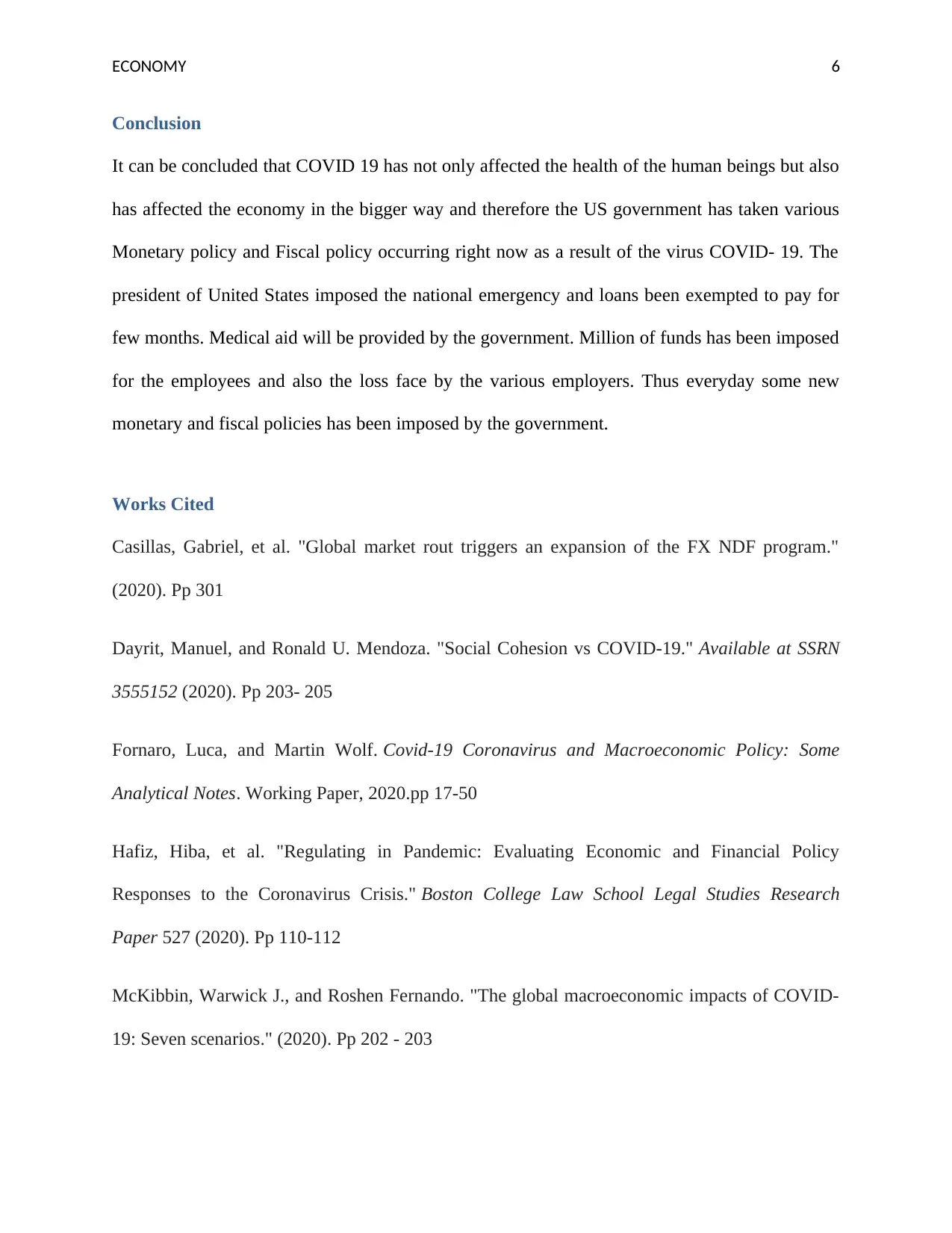
ECONOMY 6
Conclusion
It can be concluded that COVID 19 has not only affected the health of the human beings but also
has affected the economy in the bigger way and therefore the US government has taken various
Monetary policy and Fiscal policy occurring right now as a result of the virus COVID- 19. The
president of United States imposed the national emergency and loans been exempted to pay for
few months. Medical aid will be provided by the government. Million of funds has been imposed
for the employees and also the loss face by the various employers. Thus everyday some new
monetary and fiscal policies has been imposed by the government.
Works Cited
Casillas, Gabriel, et al. "Global market rout triggers an expansion of the FX NDF program."
(2020). Pp 301
Dayrit, Manuel, and Ronald U. Mendoza. "Social Cohesion vs COVID-19." Available at SSRN
3555152 (2020). Pp 203- 205
Fornaro, Luca, and Martin Wolf. Covid-19 Coronavirus and Macroeconomic Policy: Some
Analytical Notes. Working Paper, 2020.pp 17-50
Hafiz, Hiba, et al. "Regulating in Pandemic: Evaluating Economic and Financial Policy
Responses to the Coronavirus Crisis." Boston College Law School Legal Studies Research
Paper 527 (2020). Pp 110-112
McKibbin, Warwick J., and Roshen Fernando. "The global macroeconomic impacts of COVID-
19: Seven scenarios." (2020). Pp 202 - 203
Conclusion
It can be concluded that COVID 19 has not only affected the health of the human beings but also
has affected the economy in the bigger way and therefore the US government has taken various
Monetary policy and Fiscal policy occurring right now as a result of the virus COVID- 19. The
president of United States imposed the national emergency and loans been exempted to pay for
few months. Medical aid will be provided by the government. Million of funds has been imposed
for the employees and also the loss face by the various employers. Thus everyday some new
monetary and fiscal policies has been imposed by the government.
Works Cited
Casillas, Gabriel, et al. "Global market rout triggers an expansion of the FX NDF program."
(2020). Pp 301
Dayrit, Manuel, and Ronald U. Mendoza. "Social Cohesion vs COVID-19." Available at SSRN
3555152 (2020). Pp 203- 205
Fornaro, Luca, and Martin Wolf. Covid-19 Coronavirus and Macroeconomic Policy: Some
Analytical Notes. Working Paper, 2020.pp 17-50
Hafiz, Hiba, et al. "Regulating in Pandemic: Evaluating Economic and Financial Policy
Responses to the Coronavirus Crisis." Boston College Law School Legal Studies Research
Paper 527 (2020). Pp 110-112
McKibbin, Warwick J., and Roshen Fernando. "The global macroeconomic impacts of COVID-
19: Seven scenarios." (2020). Pp 202 - 203
⊘ This is a preview!⊘
Do you want full access?
Subscribe today to unlock all pages.

Trusted by 1+ million students worldwide
1 out of 6
Related Documents
Your All-in-One AI-Powered Toolkit for Academic Success.
+13062052269
info@desklib.com
Available 24*7 on WhatsApp / Email
![[object Object]](/_next/static/media/star-bottom.7253800d.svg)
Unlock your academic potential
Copyright © 2020–2025 A2Z Services. All Rights Reserved. Developed and managed by ZUCOL.





